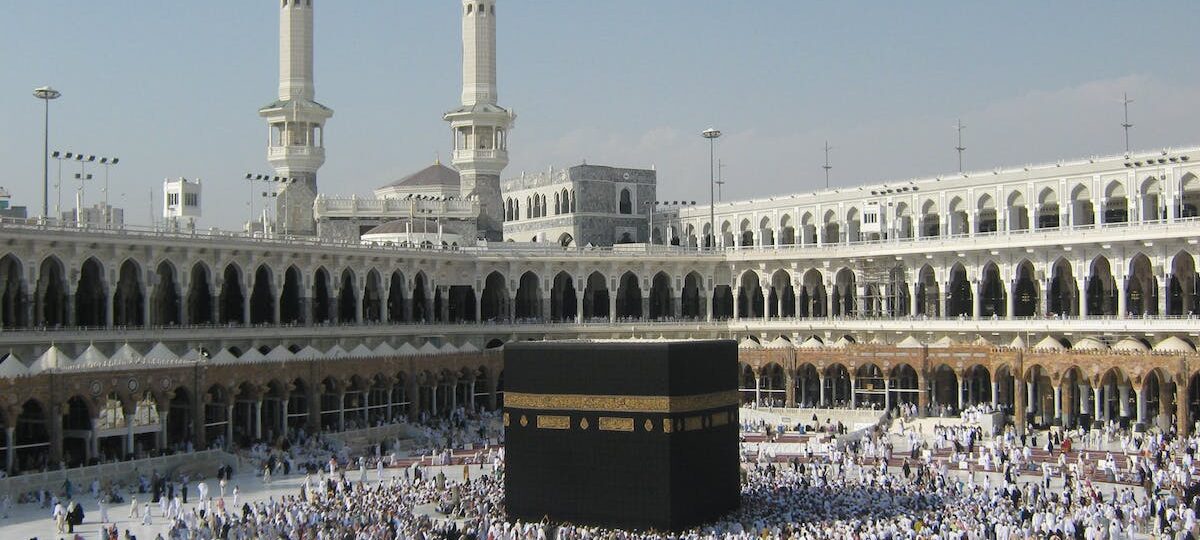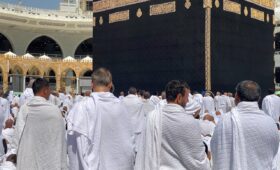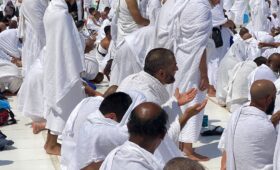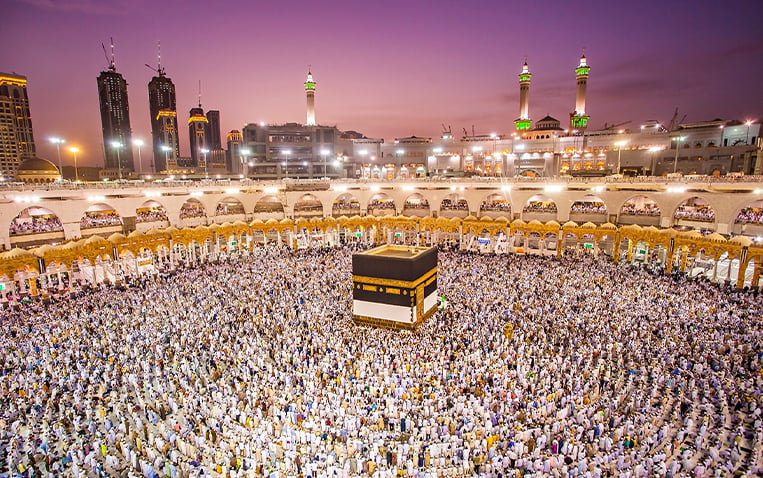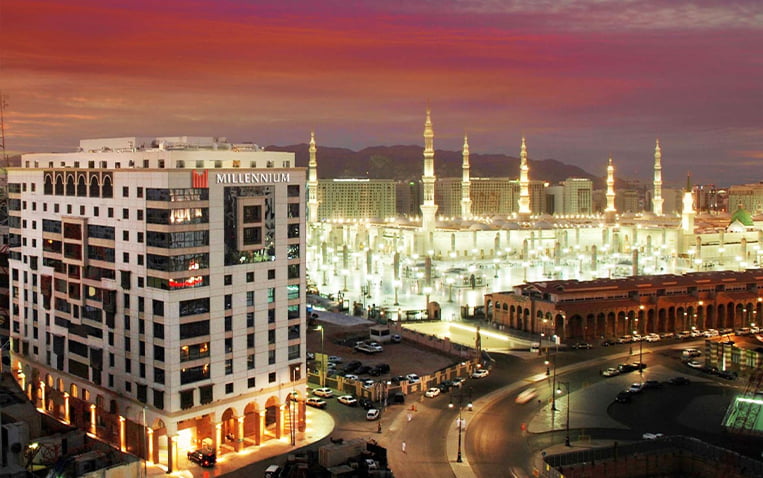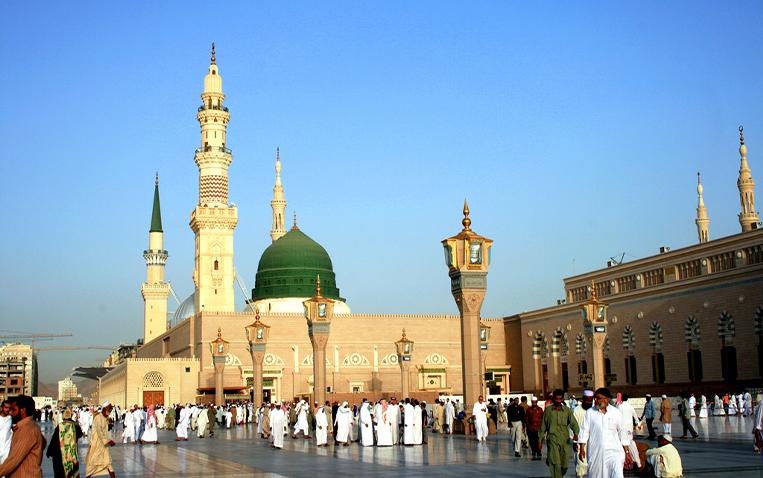Hajj and Umrah are two important Islamic pilgrimages that are spiritual journeys that Muslims undertake to seek blessings from Allah. While they both visit the holy city of Makkah and perform special rituals, they believe that participating in Hajj and Umrah also leads to the forgiveness of past sins.
But the main difference between Hajj and Umrah is their implementation and importance. These pilgrimages, have some differences.
Let’s understand what Hajj and Umrah are and how they are different.
Hajj and Umrah
Hajj
Hajj is an annual pilgrimage for Muslims and is considered one of the five pillars of Islam. The Hajj must be performed at the appointed time, that is, within the month of Hajj, especially the main prayers are performed in the first two weeks of the Hajj.
Hajj means going to the Holy Land of Baitullah in Makkah during the Hajj and performing certain acts of worship according to its conditions and rules. Hajj is a once-in-a-lifetime act of worship for those who can afford it.
According to the Quran, these rituals were carried out by the Prophet Muhammad, who wanted to leave his wife and son in the Makkah desert. It goes back to Ibraham. According to Islamic belief, performing these rituals with faith in Allah represents obedience to Allah and doing good.
Umrah
Umrah visits the holy places in Makkah each time and performs certain rituals according to requirements and rules. Umrah pilgrimage is a pilgrimage that everyone with good financial means should do once in their life.
Umrah is a sunnah and a tradition of our Prophet (BPUH) that can be performed at any time in the year except five days of hajj.
The main purpose of Umrah is to purify the soul and get rid of past sins. A Muslim can perform Umrah many times in his life. Umrah is also seen as protection from hardship and the burden of life, as pilgrims spend their money and time in the way of Allah.
Timing of Hajj and Umrah
Timing of Hajj
The biggest difference between Hajj and Umrah is timing. Hajj is an annual pilgrimage performed during the Islamic month of Muharram. Special days of Hajj are from the 8th to the 13th of Muharram, with the most important day being Arafat, which is the 9th day.
Timing of Umrah
Umrah can be performed at any time of the year other than Hajj. Umrah, also known as the “minor pilgrimage”, is not compulsory, but Hajj, one of the five pillars of Islam, is obligatory for every Muslim who has the physical and financial means to do it and who can walk.
Rituals of Umrah
Umrah has four acts of worship.
- Ihram
- Tawaf-e-Umrah
- Sa’i
- Halq or Taqsir
First, you proceed to your Ihram before Miqat, pray two rakats, make your niyah when Miqat comes, and recite Talbiyah regularly from then on.
Secondly, you can perform Tawaf-e-Umrah at the Kaaba and then perform two prayers, preferably next to Maqam Ibrahim.
Thirdly, you perform sa’i between Safa and Marwah.
Finally, you shave (Halq) or cut (Taqsir) your hair so that you can exit ihram and complete the Umrah.
Rituals of Hajj 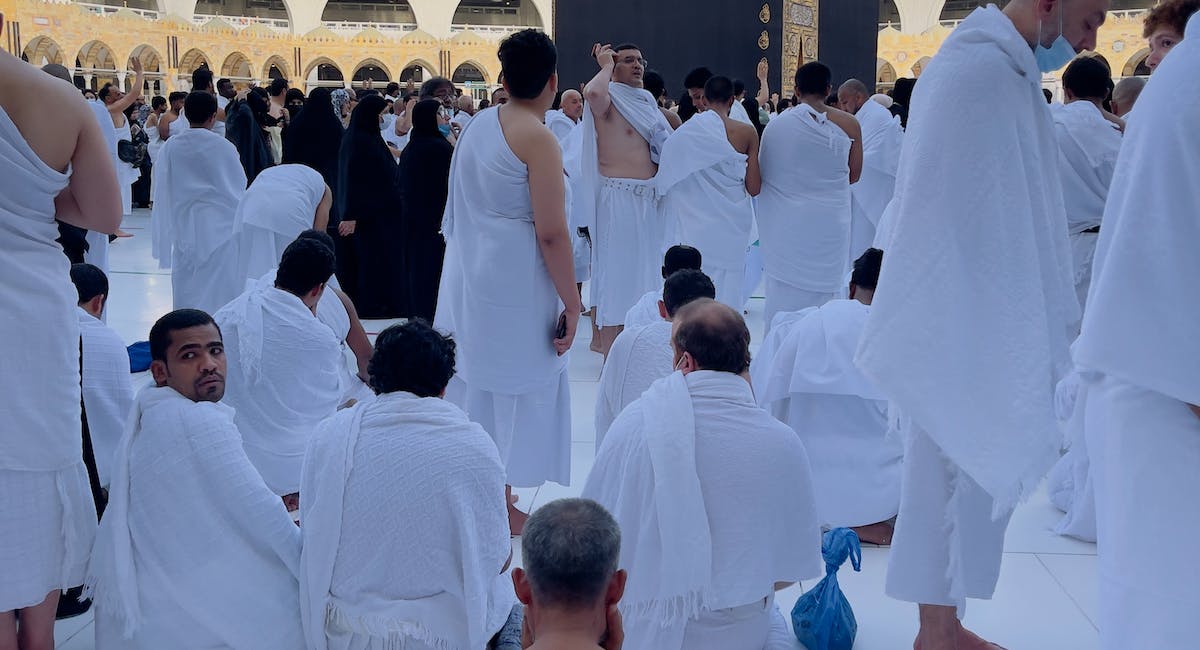
Although both Hajj and Umrah share some rituals, there are significant differences in the number and nature of rituals performed.
- Ihram
- Tawaf
- Sa’i
- Halq or taqsir (umrah end)
- Day in arafat
- Muzdalifah
- Rami al-Jamarat
- Eid al-Adha
- Tawaf al-Ifadah
Ihram
The first condition of Umrah is Ihram, which is the divine state that must be entered before starting the divine journey.
As with Hajj, pilgrims enter Ihram by dressing and complying with the relevant restrictions.
Afterwards, those who want to enter Ihram must perform ghusl, which is a very important sunnah. If you cannot perform ghusl, a bath is sufficient. Men can apply atal/perfume to their heads/beards to ensure that it does not stain their Ihram clothes.
This should all be related to your accommodation before the flight.
Tawaf
Second condition of Umrah is tawaf. Pilgrims perform Tawaf, circling the Kaaba seven times in a counterclockwise direction.
This is one of the main rituals that pilgrims perform during Umrah and Hajj. It is known that believers walking in harmony around the Kaaba is a sign of unity in worshiping Allah.
Sa’i
The third covers the journey between the mountains of Sa’i, Safa and Marwa. It shows the daily struggles of life. Remember the story of Hajar, the wife of Prophet Ibraham, searching for water for her son Ishmael in the desert. Pilgrims walk or run seven times between Mount Safa and Mount Marwa in the Grand Mosque. This ritual symbolizes determination and devotion to Allah in times of need.
Sunnah to perform sa’i immediately after tawaf, but you can rest if necessary. If you get tired or your feet hurt after Tawaf, you can rest until you are ready. Remember that you will be traveling more than three kilometers from Sa’i, so make sure you have enough energy to complete the ritual before you begin.
Safa and Marwah are two mountains located in the deep mosques of Makkah, Saudi Arabia. Umrah Sa’i includes seven sacred tours of two mountains. Pilgrims seek Allah’s blessings and mercy. It also shows the difficulties people face in their daily lives by seeking Allah’s consent and showing the courage to overcome these difficulties.
Halq/Taqsir
Last pillar of Hajj is halq which means the end of the holy Hajj. After completing Hajj, pilgrims men must shave their heads and women shorten their hair by a fingertip’s length.
After completion of Hajj and represents spiritual renewal and deliverance from past sins.
After completing the Hajj journey, pilgrims will do some activities that will take into account the religious aspects of Hajj and Umrah. Men should shave called Halq and women should cut their hair a few inches shorter called Taqsir .Muslims are freed from all kinds of travel restrictions. To perform the ritual correctly, it is necessary to comply with the rules of Folk and Duplicating, which are different for men and women.
Day in Arafat
At the height of the Hajj pilgrimage, pilgrims gather at Mount Arafat to ask for forgiveness, pray and listen to sermons. This is considered the most important day of the Hajj, because standing next to Arafat is a condition for the Hajj to be valid.
The day of Arafa is celebrated in the month of Dhu al-Hijjah to commemorate the sacrifice of Prophet Ibraham (AS). After Allah (swt) asked about the sacrifice of his son Ishmael (AS), Ibrahim (AS) took Ishmael (AS) to the top of Mount Arafa.
This is where Allah (SWT) performed a miracle, saving Ishmael (AS) and replacing him with a ram as a reward for his unwavering faith in Him.
Muzdalifah
Muzdalifah is the most important place in the history of Islam because this place can change a person’s heart and life forever. This is where pilgrims spend the night before casting the devil. Every traveler has a new decision in his mind and makes the same again while collecting stones.
After sunset on Arafat, people go to Muzdalifah, the open area between Arafat and Mina. They performed the morning prayer and fast together and spent the night outdoors. In Muzdalifah, pilgrims also collect pebbles for the Rami Al-Jamarat ceremony.
Rami al-Jamrat
The stoning of three jamarat in Mina lasted for three days. This ritual was performed by Prophet Muhammad, who threw stones at the devil while trying to prevent him from fulfilling Allah’s command. By repeating the story of Ibraham, it shows the rejection of the devil’s temptations.
Jamarat is a variant of the Arabic Jamrah, meaning small stones or pebbles. In the context of the Community Hajj, this word refers to the pilgrims throwing pebbles at the three pillars to deny sin and ask God for strength.
The best time to perform rami al-jamrat is Sunrise to midday (10 minutes before the beginning of Dhuhr Salah). Try to perform Rami at this time, provided it isn’t too crowded. Between midday and sunset.
Eid al-Adha
Eid al-Adha is celebrated on the 10th day of Muharram and is the end day of Hajj. Pilgrims (or those who can do this) slaughter animals, usually sheep or goats. The meat is then distributed to family, friends and those in need.
Although Eid al-Adha is not directly related to the Hajj, it has a physical importance as it is just one day before the end of the Hajj. Eid al-Adha, is a holiday celebrated to commemorate Abraham’s faith and devotion to God. He was ready to sacrifice his son Ishmael.
When the sacrifice was made, Allah SWT replaced Ishmael with a ram and it was sacrificed in place of his son. This order of Allah SWT, It is a test of Abraham’s willingness and determination to obey God’s command without question. Therefore, Eid al-Adha means the feast of sacrifice.
Tawaf al-Ifadah
The state of ihram ended and all restrictions, the final Tawaf, also known as Tawaf al-Ziyarah, is a ritual that must be performed after all other Hajj rituals have been completed. It marks the completion of the pilgrimage and the pilgrimage to the Kaaba.
Tawaf al-Wada means “Farewell to Tawaf”. The ritual is performed by pilgrims after completing the Hajj before leaving , the House of Allah in Mecca, Saudi Arabia. It is necessary to perform the farewell tawaf, which is the last act of Hajj, before going to another place.
Obligatory Acts
For Umrah, after declaring the intention of Umrah, it is necessary to put on Ihram, perform Tawaf, perform the ritual between Safa and Marwa Mountains and finally shave or cut your hair.
However, during the Hajj, it is necessary to enter the ihram from the Miqat, stay in Arafat until sunset, spend the night in Muzdalifah, spend the night in Mina during the tashriq, wear the jamaat, shave, and the final journey. It is important to note that both pilgrimages will be considered completed only after all these requirements are met.
Significance of Hajj
Both Hajj and Umrah have spiritual significance for Muslims, but Hajj holds more significance as it is an obligatory act of worship.
Hajj symbolizes unity and Muslims from different nations come together to perform the pilgrimage. It is also an opportunity to seek spiritual purification and forgiveness of sins.
Hajj is an important part of Islam, it covers one of its five pillars and holds an important place in our religion. As Muslims, we understand the historical and spiritual significance of the Hajj, but we need to explain the rituals of the Hajj to non-Muslims to increase understanding and awareness of our journey.
Significance of Umrah
Although Umrah is not mandatory, it is highly recommended and can be performed many times. It also has spiritual benefits such as purifying the soul, getting closer to Allah , and getting good results.
Umrah is an intimate pilgrimage that can be performed many times a year. Both pilgrimages provide spiritual experiences that strengthen Muslims’ faith, purify their hearts, and promote unity among Muslim communities worldwide.
Umrah gives Muslims the opportunity to renew their faith, ask for forgiveness, pray for their needs and purify themselves from their sins. Additionally, Umrah is considered one of the best things a person can do to get closer to God Almighty.
By understanding the difference between Hajj and Umrah, Muslims can better understand the meaning of these pilgrimages and begin their spiritual journey with more clarity and meaning. Participation in Hajj or Umrah allows believers to understand their relationship with God and experience personal growth while fulfilling their religious duties and affirming the heritage, richness and culture of Islam.
Similarities Between Hajj and Umrah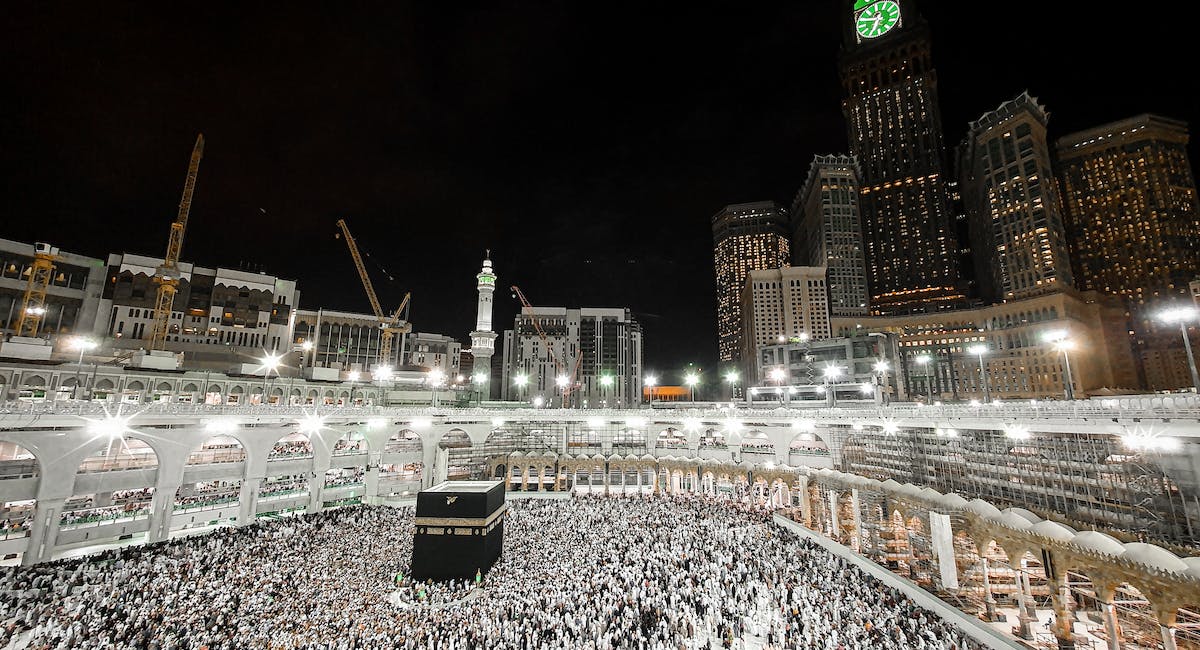
- The main purpose of Hajj and Umrah is to worship Allah and strengthen the faith of pilgrims.
- Both want Muslims to go to Saudi Arabia and start rituals in the Kaaba.
- Hajj and Umrah are pilgrimages that bring together Muslim communities all over the world and provide a sense of unity.
- It is both reward and blessing, and both help in erasing sins and protecting you
- Similar rituals between the two include circumambulation of the Kaaba, sa’ of Safa and Marwa, and cutting of the hair upon completion. of pilgrimage.
- Both pilgrimages require Muslims to wear the holy good deeds.
- Both have similar limitations when it comes to staying away from sin and evil.
Conclusion
Hajj and Umrah are significant and significant spiritual pilgrimages, but they differ in time, ceremony and importance. The Quran and Hadiths provide insight into the rewards of each journey, emphasizing the importance of sincerity and observance of rituals. Muslims have the opportunity to purify their souls, get closer to Allah and strengthen the unity of the Muslim world community. Understanding these differences and the gifts mentioned in Islamic texts enables believers to enter these spiritual journeys with a clear sense of purpose and commitment to them, eventually fulfilling their religious obligations and accepting the riches of Islam.
FAQs
Rewards of umrah and hajj the same ?
Although Hajj and Umrah are both beneficial acts of worship, the rewards of Hajj are valued more because their rules and traditions are similar. However, the sincerity and sacrifice shown by the person performing the pilgrimage determines the spiritual benefits and blessings he will receive.
Is Hajj more important than Umrah?
Hajj is more important and rewarding than Umrah, but it can only be done at certain times of the year and involves many stages.
Is 3 Umrah equal to Hajj?
There are two important pilgrimage sites in Islam. Now, technically, performing Umrah three times does not equal the reward of one Hajj.
Which namaz is equal to Hajj or Umrah?
Attending the Eid al-Fitr prayer is equivalent to the reward of Umrah, and attending the Eid al-Adha is equivalent to the reward of Hajj.

